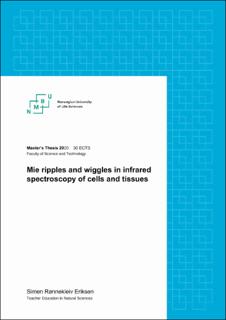| dc.contributor.advisor | Kohler, Achim | |
| dc.contributor.advisor | Brandsrud, Maren Anna | |
| dc.contributor.author | Eriksen, Simen Rønnekleiv | |
| dc.coverage.spatial | Norway | en_US |
| dc.date.accessioned | 2020-12-10T14:08:49Z | |
| dc.date.available | 2020-12-10T14:08:49Z | |
| dc.date.issued | 2020 | |
| dc.identifier.uri | https://hdl.handle.net/11250/2716978 | |
| dc.description.abstract | Micro-spectroscopy yields chemical information about the microscopic structures in biological tissues in its native form. The great challenge of it is to understand the dynamics of scattered and absorbed light, which makes the extinguished light. The extinguished light is the light apparently absorbed from raw data. Hence the understanding of scattering and absorbance can make out what part of this raw spectrum was pure absorbance. Tools such as Extended Multiplicative Signal Correction (EMSC) and Mie Extinction EMSC (ME-EMSC) does the job of recovering pure absorbance spectra from raw spectra. This thesis uses Mie Theory to examine the scattering and absorbance from three microscopic particles: A sphere and two cylinders with different refractive indexes and radii. The dominant scattering effects from $\mu$m-sized particles are ripples and wiggles. Ripples are sharp peaks (thin needles) in the extinction efficiency factor, while wiggles are the greater variance in the extinction efficiency factor (wide oscillations). Absorption bands are modeled by the Lorentz model, and moved into places where ripples are found originally on the particles. This thesis predicts by Mie Theory that the absorbance bands creates inverted peaks in the extinction efficiency factor when placed in place with ripples on the top of a wiggle, and a peak when the ripple is placed on the bottom of a wiggle. The inverted peaks are found in apparent absorbance spectra from micro Fourier Transform Infrared (FTIR) imaging, which earlier have been discarded as artefacts, but are in fact signatures of absorption bands. When the absorption band is moved into a ripple which is placed mid-way on the wiggle, the ripple disappear, leaving almost no trace of neither absorbance band or ripple. The role of the numerical aperture (NA) is studied as well, and it is found that ripples are not affected by the NA. | en_US |
| dc.description.abstract | Mikro-spektroskopi gjev kjemisk informasjon om dei mikroskopiske strukturane i biologiske vev, i deira originale form. Den store utfordringa er å forstå dynamikken mellom spreidt og absorbert lys, som til saman utgjer lyset som er kverva. Det kverva lyset er det lyset som ser ut til å ha blitt absorbert basert på det målte absorpsjonsspektrumet. Dermed kan kjennskapen om spreiing og absorpsjon avgjere kva del av det målte spektrumet var rein absorpsjon. Verktøy som "Extended Multiplicative Signal Correction" (EMSC) og "Mie Extinction EMSC" (ME-EMSC) hentar ut reine absorpsjonsspektrum utifrå målte absorpsjonsspektrum. Denne masteroppgåva nyttar Mie teori til å utforske spreiinga og absorpsjonen frå tre mikroskopiske partiklar: Ei kule og to sylindrar med ulike brytningsindeks og radiusar. Mesteparten av spreiing ifrå partiklar i $\mu$m-ordenen kjem ifrå fenomena "ripples" og "wiggles". "Ripples" er tynne nålar som stikk opp av effektivitetsfaktoren for kverving, medan "wiggles" er ein større variasjon i effektivitetsfaktoren for kverving (vide svingningar). Absorpsjonband er modellert ved hjelp av Lorentzmodellen, og flytta inn der "ripples" originalt vart funnen. Denne masteroppgåva føreser ved hjelp av Mie teori at absorpsjonsband skapar omvendte toppar i effektivitetsfaktoren for kverving når dei er plassert på toppen av ein "wiggle", og ein vanleg topp når dei er på botnen av ein "wiggle". Omvendte toppar er funnen i målte absorpsjonsspektrum ifrå mikro Fourier Transform Infraraud (FTIR) bilete, som tidlegare har blitt forkasta som artefaktar, men som visar seg å vere signaturar for absorpsjonsband. Når eit absorpsjonsband blir flytta inni ein "ripple" som er plassert på midten av ein "wiggle", forsvinnar "ripple"-en og etterlatar seg knapt noko spor etter seg, ei heller absorpsjonsbandet. Rolla til numerisk apertur (NA) er også blitt studert, og det er funnen at NA ikkje påverkar "ripple"-ar. | en_US |
| dc.language.iso | eng | en_US |
| dc.publisher | Norwegian University of Life Sciences, Ås | en_US |
| dc.rights | Attribution-NonCommercial-NoDerivatives 4.0 Internasjonal | * |
| dc.rights.uri | http://creativecommons.org/licenses/by-nc-nd/4.0/deed.no | * |
| dc.subject | Infrared spectroscopy | en_US |
| dc.subject | Mie Theory | en_US |
| dc.title | Mie ripples and wiggles in infrared spectroscopy of cells and tissues | en_US |
| dc.type | Master thesis | en_US |
| dc.description.version | submittedVersion | en_US |
| dc.subject.nsi | VDP::Matematikk og Naturvitenskap: 400 | en_US |
| dc.subject.nsi | VDP::Teknologi: 500 | en_US |
| dc.source.pagenumber | 111 | en_US |
| dc.description.localcode | M-MF | en_US |

